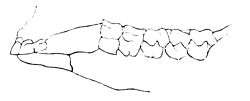Polyphyodont

A polyphyodont (/ˌpɑːlᵻˈfaɪəˌdɑːnt/) is any animal whose teeth are continuously replaced. In contrast, diphyodonts are characterized by having only two successive sets of teeth.[1]
Polyphyodonts include most toothed fishes, many reptiles such as crocodiles, geckos,[2][3][4] and most other vertebrates, mammals being the main exception. New, permanent teeth grow in the jaws, usually under or just behind the old tooth, from stem cells in the dental lamina.[5] Young animals typically have a full set of teeth when they hatch; there is no tooth change in the egg. Within days, tooth replacement begins, usually in the back of the jaw continuing forward like a wave. On average a tooth is replaced every few months.
Crocodilia are the only non-mammalian vertebrates with tooth sockets.[6] Alligators grow a successional tooth (a small replacement tooth) under each mature functional tooth for replacement once a year, each tooth being replaced up to 50 times in the alligator's life.[7] Crocodilia are researched for tooth regeneration in humans.[8]
Evolution in mammals
Kangaroos, elephants[9] and manatees are unusual among mammals because they are polyphyodonts, in contrast to most other mammals which replace their teeth only once in their lives (diphyodont). Although most extant mammals are not polyphyodont, mammalian ancestors were. During the evolution of Therapsida, there was a period during which mammals were so small and short-lived that wear on the teeth yielded no significant selection pressure to constantly replace them. Instead, mammals evolved different types of teeth which formed a unit able to crack the exoskeleton of arthropods. Molars came later in their evolution (as earlier in cerapods and Diplodocus[10]). Mammals chew (masticate) their food which requires a set of firmly attached, strong teeth and a "full" tooth row without gaps.
The manatees have no incisor or canine teeth, just a set of cheek teeth, which are not clearly differentiated into molars and premolars. These teeth are continuously replaced throughout life, with new teeth growing at the rear as older teeth fall out from farther forward in the mouth, a process known as "hind molar progression" or “Marching Molars”.[11]
See also
- Regeneration (biology)
- Regenerative medicine
- Regenerative endodontics
- Schultz's rule
- Sinoconodon
- Squamata
- Tooth development
References
- ↑ Buchtova, M.; Stembirek, J.; Glocova, K.; Matalova, E.; Tucker, A. S. (2012). "Early Regression of the Dental Lamina Underlies the Development of Diphyodont Dentitions". Journal of Dental Research. 91 (5): 491–498. doi:10.1177/0022034512442896.
- ↑ Mechanism of tooth replacement in Leopard geckos
- ↑ Fuenzalida, Marcela; Lemus, Susi; Illanes, Julio; Montiel, Enrique; Acuña, Olga; Lemus, David (2000). "Histochemical detection of sugar residues in lizard teeth (Liolaemus gravenhorsti): a lectin-binding study". Biological Research. 33 (3-4). doi:10.4067/S0716-97602000000300008.
- ↑ Gaete, Marcia; Tucker, Abigail S.; Schubert, Michael (2013). "Organized Emergence of Multiple-Generations of Teeth in Snakes Is Dysregulated by Activation of Wnt/Beta-Catenin Signalling". PLoS ONE. 8 (9): e74484. doi:10.1371/journal.pone.0074484.
- ↑ Whitlock, John A; Richman, Joy M (2013). "Biology of tooth replacement in amniotes". International Journal of Oral Science. 5 (2): 66–70. doi:10.1038/ijos.2013.36.
- ↑ LeBlanc, Aaron R. H.; Reisz, Robert R.; Viriot, Laurent (2013). "Periodontal Ligament, Cementum, and Alveolar Bone in the Oldest Herbivorous Tetrapods, and Their Evolutionary Significance". PLoS ONE. 8 (9): e74697. doi:10.1371/journal.pone.0074697.
- ↑ Wu, Ping; Wu, Xiaoshan; Jiang, Ting-Xin; Elsey, Ruth M.; Temple, Bradley L.; Divers, Stephen J.; Glenn, Travis C.; Yuan, Kuo; Chen, Min-Huey; Widelitz, Randall B.; Chuon, Cheng-Ming (2013). "Specialized stem cell niche enables repetitive renewal of alligator teeth" (PDF). Proceedings of the National Academy of Sciences of the United States of America. 110 (22): E2009–E2018. doi:10.1073/pnas.1213202110. PMC 3670376
 . PMID 23671090.
. PMID 23671090. - ↑ Wu P, Wu X, Jiang TX, Elsey RM, Temple BL, Divers SJ, et al. (2013). "Specialized stem cell niche enables repetitive renewal of alligator teeth.". Proc Natl Acad Sci U S A. 110 (22): E2009–18. doi:10.1073/pnas.1213202110. PMC 3670376
 . PMID 23671090.
. PMID 23671090. - ↑ Higgins, D. and James, H. (2015). "Odontology opinions". Forensic Odontology: Principles and Practice. pp. 377–401.
- ↑ D’Emic, Michael D.; Whitlock, John A.; Smith, Kathlyn M.; Fisher, Daniel C.; Wilson, Jeffrey A.; Evans, Alistair Robert (2013). "Evolution of High Tooth Replacement Rates in Sauropod Dinosaurs". PLoS ONE. 8 (7): e69235. doi:10.1371/journal.pone.0069235. PMC 3714237
 . PMID 23874921.
. PMID 23874921. - ↑ Manatee adaptations: the head